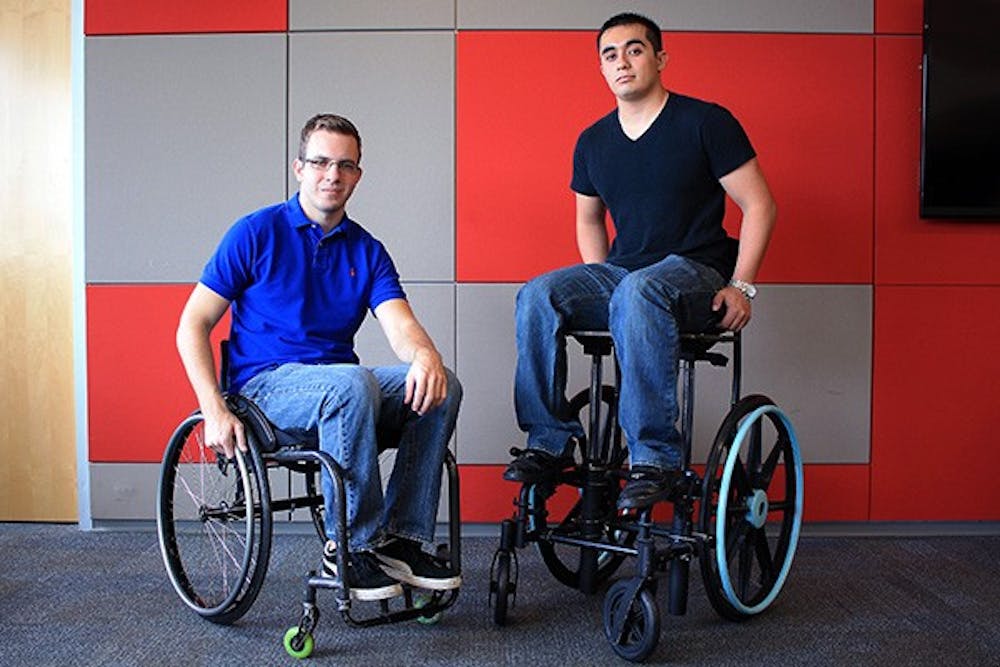 Supply chain management alumnus Peter Georgiou (left) sits on a conventional wheel chair and bio-medical engineering graduate student Chris Miranda sits on an elevated wheel chair, illustrating the difference in heights that can be achieved through this new innovation. The elevated chair aims to increase the elevation of the user by ten inches. (Photo by Shiva Balasubramanian)
Supply chain management alumnus Peter Georgiou (left) sits on a conventional wheel chair and bio-medical engineering graduate student Chris Miranda sits on an elevated wheel chair, illustrating the difference in heights that can be achieved through this new innovation. The elevated chair aims to increase the elevation of the user by ten inches. (Photo by Shiva Balasubramanian)
Four ASU seniors from different majors teamed up in fall 2012 to create UP — an elevating wheelchair that would simplify life for people with disabilities.
Supply chain management alumnus Peter Georgiou graduated in 2013, as did two other team members. However, the team continues meeting weekly to design a cheaper light elevating wheelchair that would increase the freedom of people with disabilities.
“With this wheelchair, we hope to give people independence and re-establish sense of normalcy,” he said.
After talking to people with disabilities and roaming around the campus in a wheelchair to gain better understanding of their life, students noticed that vending machines, bar counters and other places can be located too high for people in wheelchairs, whose height is about two feet lower than people who are standing.
“You begin to realize that things are out of reach, everything is meant for people of average height,” Georgiou said.
The wheelchair the team has designed elevates by 10 inches to allow people with disabilities to choose the height they need according to the place or situation.
The project also aims to solve a social problem of inequity that occurs because of the difference in the height between disabled and able-bodied persons. A person in the wheelchair can easily elevate the height of the wheelchair to have comfortable eye contact during a face-to-face interaction with a standing able-bodied person.
“People are literally looking down on them (people in wheelchairs),” Georgiou said. “And that’s the problem we’ve got to solve.”
Students started UP Wheelchair in fall 2012 after ASU’s InnovationSpace program put seniors from engineering, graphic and industrial design and business backgrounds together.
 A team of four ASU students in the Innovation Space program have designed an elevated wheelchair that aims to simplify the lives of people with disabilities. (Photo by Shiva Balasubramanian)
A team of four ASU students in the Innovation Space program have designed an elevated wheelchair that aims to simplify the lives of people with disabilities. (Photo by Shiva Balasubramanian)
Since then, the team has created the first prototype, which was a redesign of a regular wheelchair to make it elevate. Now, with the assistance of engineers and people familiar with the lifestyle involving wheelchairs, the team is working on designing and building the second prototype from scratch.
This is the team’s second year as a part of the Edson Student Entrepreneur Initiative, which provides student ventures with workspace, resources, legal and website discounts and funding. Student venture UP was one of the 20 projects selected this year to participate in the program.
The team, according to the rules of Edson Student Entrepreneur Initiative, had a year to have its project up and running, and since it was going well they could reapply to enter one more time.
“They let you make a lean start-up where it is quick and you don’t spend too much money,” Georgiou said. “The premise is to see no one fail but if you do fail — fail fast without wasting months or years on idea that won’t work. They want us to get our hands dirty quick.”
Tracy Lea, venture manager at ASU Entrepreneurship and Innovation group, said the team’s initial prototype has changed a lot because the teammates reached out to potential customers to learn more about their needs.
“I think the project has the opportunity to give anybody greater mobility and greater freedom and to be able to have an active lifestyle," she said. "I think it’s fantastic."
Georgiou, who is responsible for the financial part of the project, said the blend of diverse academic backgrounds of the team members allows them to bring different inputs and perspectives to enhance the wheelchair.
“By having all of us in different quadrants of what’s needed, we get that full picture,” Georgiou said.
Biomedical engineering graduate student Chris Miranda is in charge of the technical side of the project. He said the teammates sometimes argue about the project but they have learned from the insights.
“When you’re working on (an) idea for so long, it almost becomes yours, like it’s almost you,” Chris said. “If somebody insults your idea, you take it personally. I think we learned to argue well as a team. There’s always conflict, there has to be, but that’s how you move forward.”
Reach the reporter at kmaryaso@asu.edu or follow on Twitter @KseniaMaryasova
Like The State Press on Facebook and follow @statepress on Twitter.




